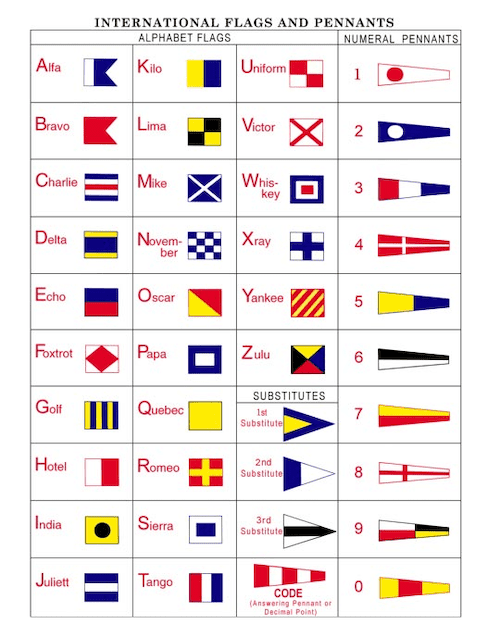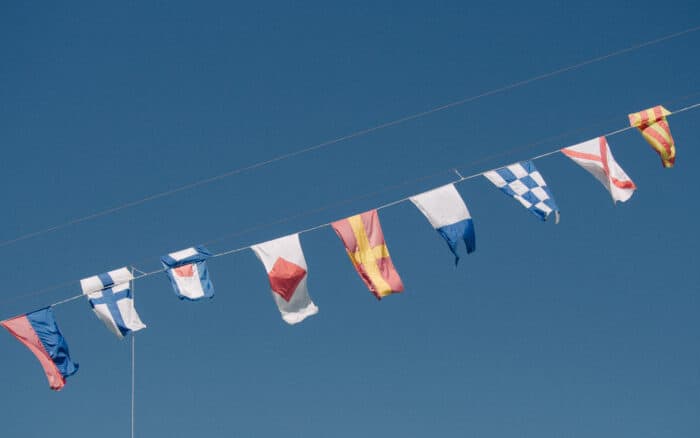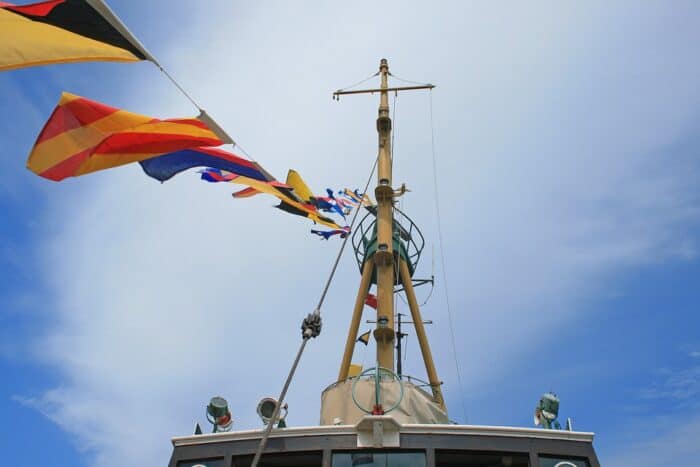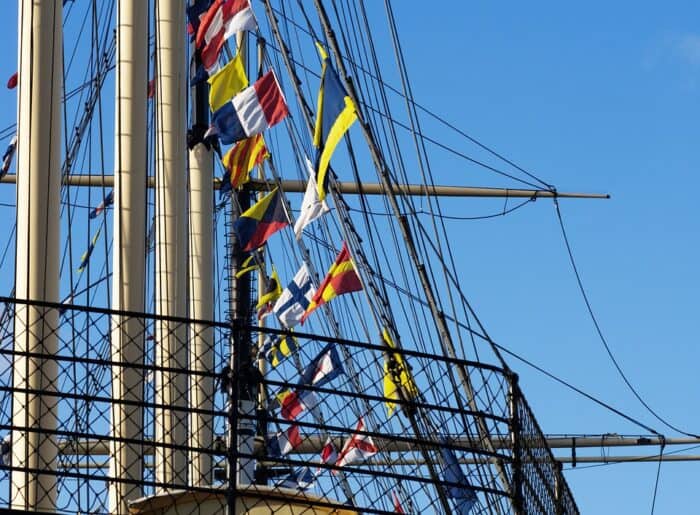The Nautical Flag Alphabet for Beginners
The nautical flag alphabet, also known as international maritime signal flags, is a system of 26 flags. In addition there are:
- 10 numeral pennants
- 3 substitute pennants
- 1 answering pennant
These are used as communications tools on boats and they date back a considerable length of time. The nautical alphabet flags rely on a signal flag or code flag combination that can have meaning that transcends language.
Nautical Flag Alphabet Meanings
 | A or Alfa Flag | Diver down, keep clear |
 | B or Bravo Flag | Carrying dangerous goods or cargo |
 | C or Charlie Flag | Affirmative/Yes |
 | D or Delta Flag | Keep clear, maneuvering with difficulty |
 | E or Echo Flag | Altering course to starboard |
 | F or Foxtrot Flag | Disabled, please communicate with me |
 | G or Golf Flag | I require a pilot or, on a fishing vessel, I’m hauling nets |
 | H or Hotel Flag | Pilot on board |
 | I or India Flag | Altering course to port |
 | J or Juliett Flag | Fire on board or leaking dangerous cargo, stay clear |
 | K or Kilo Flag | I wish to communicate with you |
 | L or Lima Flag | Stop your vessel instantly, I need to communicate with you right away |
 | M or Mike Flag | My vessel has stopped and is making no way |
 | N or November Flag | No/Negative |
 | O or Oscar Flag | Man overboard |
 | P or Papa Flag | In port to mean vessel is about to set sail/all hands need to come aboard. At sea indicates nets have come upon an obstruction |
 | Q or Quebec Flag | I request free pratique which means everyone on board is healthy and the boat wishes permission to dock. |
 | R or Romeo Flag | The Romeo flag has no single specific ICS meaning and can mean several things when combined with others or as a Navy signal. |
 | S or Sierra Flag | Operating with astern propulsion |
 | T or Tango Flag | Keep clear. For fishing vessels it means keep clear, engaged in trawling |
 | U or Uniform Flag | You are heading towards danger |
 | V or Victor Flag | Assistance required |
 | W or Whiskey Flag: | I require medical assistance |
 | X or X-Ray Flag | Stop what you’re planning on doing and wait for further signals |
 | Y or Yankee Flag | Dragging my anchor |
 | Z or Zulu Flag | I require a tug |
There are also numerical pennant flags and substitute flags which you can see on this table here.

Why are Nautical Flags Important and What Do They Do?

Even though in the modern world boats are equipped with VHF radios and other advanced forms of communications, nautical signal flags are still employed because of what they can represent in an international way. That means that nautical flags are able to convey meaning between boats at sea quickly and relatively easily, even in the face of technology breakdowns or language barriers.
For the 26 flags of the nautical flag alphabet, each flag has two meanings. One is a simple letter meaning and each flag is ascribed one letter, A through Z, which can be used to spell out words. However, according to the International Code of Signals, each flag has a specific meaning that transcends language to allow quick communication between vessels no matter their country of origin.
Nautical Signal Flags and Their Colors
There are only five colors you will see in nautical signal flags.
- Red
- Blue
- Yellow
- Black
- White
These colors stand out against the background of the sea or sky on individual flags whether they be letter flags or number flags. They have proven to be some of the easiest for people to see on boats either with the naked eye or with binoculars.
If you see flags of other colors they are not official signal flags.
Multiple Nautical Flag Alphabet Signs

We’ve seen what single flags can mean but there are times when a vessel may use multiple flags, not just to spell out words with the alphabet, but to convey specific meanings.
- One Flag: These signals are urgent or extremely common signals which is why they are conveyed with a single flag. The message can be relayed very quickly.
- Two Flags: These signals are reserved for conveying information about maneuvering or distress.
- Three Flags Or More: These flag signals are used for things like compass directions, bearings, code and decode signals, geographical signals and more.
- Up to seven flags can be used to convey meanings.
Multiple Flag Meanings

The following is a brief list of the some meanings for combining two nautical flags (and sometimes more) that you may see at sea. Some are more common than others.
- A+C: I am abandoning my vessel
- A+E: I have to abandon ship
- A+F: I am not abandoning ship
- A+G: You need to abandon ship
- A+H: You should not abandon ship
- A+L: I have a doctor on board
- A+M: Do you have a doctor on board?
- A+N: I need a doctor
- A+N+1: Need a doctor, have been burned
- B+P: Aircraft is coming to assist
- B+R: I require a helicopter immediately
- C+B: I require immediate assistance
- C+B+6: I require assistance immediately, I am on fire
- C+J: Do you need help?
- C+K: I no longer need help
- C+P: I am coming to help
- C+V: I am unable to help
- C+W: Boat or raft is on board
- D+D: Boats cannot come alongside
- D+V: I am drifting
- D+X: I am sinking
- E+D: I understand your distress signals
- E+F: SOS or Mayday has been canceled
- E+L: Repeat distress position
- E+L+1: What is the position of the vessel that is in distress?
- E+P: I can no longer see you
- E+X: Unsure of my position
- E+Y: I am sure of my position
- F+A: Please tell me my position
- F+E: Heading to the accident location at full speed
- F+N: I’ve lost contact with vessel
- F+O: I will stay close to your vessel
- G+A: I cannot continue to search
- G+B” You should stop searching and return home or continue onward
- G+M: I cannot save my vessel
- G+N: You should take off persons
- G+N+2: I will take off persons
- G+O: I cannot take off persons
- G+Q: I cannot proceed to rescue due to weather. You should do whatever you can
- G+W: Man overboard, please take action to rescue him
- G+Z: Everyone has been saved
- G+Z+1: Everyone has been lost
- H+M: Survivors in dire need of medical assistance
- H+W: I have collided with another vessel
- I+B+1: Vessel is seriously damaged
- I+M: Requesting escort
- I+N: I require a diver
- I+R: I am doing work underwater, proceed slowly and keep clear
- I+T: I am on fire
- J+B: Danger of explosion
- J+G: I am aground, in danger
- J+H: I am aground, not in danger
- J+I: Are you aground?
- J+L: You are risking running aground
- J+W: I have a leak
- K+F: Tug required
- K+K: Towing impossible under current conditions
- K+N: I can’t tow you
- K+P: Please tow me to the nearest port/anchorage
- L+I: I am increasing my speed
- L+J: I am reducing my speed
- L+R: Bar is not dangerous
- L+S: Bar is dangerous
- L+X: Canal is clear
- L+Y: Canal is not clear
- M+B: Keep to the center of the channel
- M+C: Proceed with caution, there is an uncharted obstruction
- M+O: I have hit a submerged obstruction
- M+S: Vessel has dangerous radiation
- M+Y: It is too dangerous to stop
- N+A: Navigation is closed
- N+C: I require immediate assistance
- N+D: Tsunami approaching, take caution
- N+E: Proceed with extreme caution
- N+F: You are heading towards danger
- N+G: You are in a dangerous spot
- N+O: Negative
- N+T: What is your draft?
- O+H: Keep watch on your radar
- O+I: I have no radar
- O+K: Correct
- O+S: Mines in area
- P+D: I cannot see your navigation lights
- P+H: Steer as indicated
- P+H+1: Steer towards me
- P+K: I cannot steer without help
- P+M: Follow in my wake
- P+O: Pass ahead of me
- P+P: Keep clear of me
- P+S: Don’t come any closer
- Q+C: Wait until high water
- Q+C+1: Wait until low water
- Q+D: I’m going ahead
- Q+F: I cannot go ahead
- Q+I: I am going astern
- Q+K: I cannot go astern
- Q+O: You should not come alongside
- Q+Q: I require health clearance
- Q+T: You shouldn’t anchor
- Q+U: Anchoring is not allowed here
- Q+X: Requesting permission to anchor
- R+A: My anchor is foul
- R+B: I’m dragging my anchor
- R+L: Stop engines immediately
- R+M: My engines have stopped
- R+P: Landing here is dangerous
- R+S: No one is allowed on board
- R+T: Stop what you’re doing and watch my signals
- R+U: Keep clear, I am having trouble maneuvering
- S+C: I am underway
- S+D: I am not ready to get underway
- S+G: My present speed is (number) knots
- S+O: You should stop or heave to
- S+T: What is your cargo
- S+Z: Total people on board is (number)
- T+P: Fishing gear has fouled my prop
- T+V: Fishing is prohibited in this area
- T+Z: Can you offer assistance?
- U+H: Can you lead me into port?
- U+L: All vessels need to proceed to sea, there is danger in port
- U+M: Harbor is closed
- U+O: You cannot enter harbor
- U+P: Urgent permission needed to enter harbor, I have an emergency
- U+W: Pleasant voyage
- V+L: Tropical storm is approaching, take precautions
- W+W: What are weather conditions in your area?
- X+P: I am stopped by thick fog
- X+R: Weather is good
- X+R+1: Weather is bad
- Y+K: I am unable to answer you
- Y+N: Cancel last message
- Y+Y: I wish to communication by VHF radio
- Y+Z: I am going to spell a word with my next signals
- Z+E: Come within visual signal range
- Z+L: Your signal has been received but not understood
- Z+W: I require the port medical officer
Can I Write Using a Nautical Flag Alphabet Font?
If you’re interested in making quick documents as a lesson plan or as a guide to have on your vessel in case of an emergency there are a number of websites that have free Nautical Flag fonts you can download. You can find one here and another one here.
The Bottom Line
Though modern electronic communications is obviously the most fast and efficient way to talk to other vessels, emergency services or those on land, it’s not always an option or not always the best option. The International Code of Signals can convey meaning anytime and anywhere no matter what language boaters speak, especially in emergencies. It’s essential for any serious boater to become familiar with the flags and their meanings not just so that you can express yourself to others but also so you can understand others who may have important information or require assistance from you as well.
Categories: Boats











